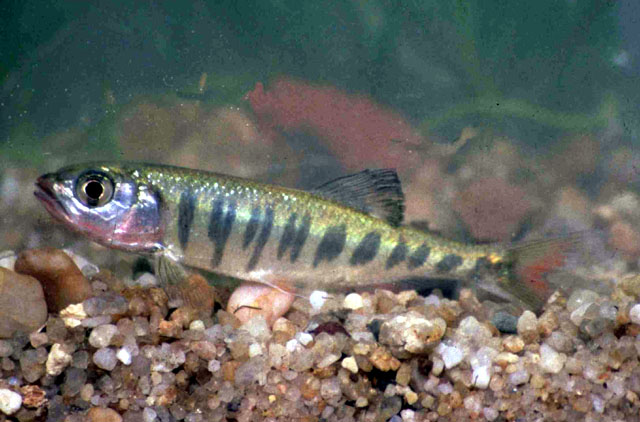
|
Opsaridium zambezense (Peters, 1852) Barred minnow |

|
|
photo by
Gratwicke, B. |
| Family: | Danionidae (Danios), subfamily: Chedrinae | |||
| Max. size: | 12 cm SL (male/unsexed) | |||
| Environment: | benthopelagic; freshwater; pH range: 6.5 - 7; dH range: 8 - 12 | |||
| Distribution: | Africa: Zambezi, Okavango, Pungwe, Limpopo, and Buzi River systems southwards to the Pongolo River; absent in Kafue and Cunene Rivers (Ref. 7248, 52193). Also in the Luapula River system in Democratic Republic of the Congo and Zambia; records from southern tributaries of the Congo (Kasai, Luachimo, Chiumbe, Kwilu) may represent an other, unidentified species (Ref. 26673). | |||
| Diagnosis: |
Dorsal spines (total): 0-0; Dorsal soft rays (total): 11-13; Anal spines: 0-0; Anal soft rays: 13-17. Diagnosis: With striking vertical bars, lateral line curving down towards the ventral surface of the body and a large curved mouth (Ref. 13337).The dorsal fin is rounded; barbels absent (Ref. 13337). Description: Body slender, spindle-shaped, with narrow caudal peduncle (Ref. 52193). Head pointed; eyes large; mouth large, extending to below orbits (Ref. 52193). Mature males with conical tubercles on tip of snout, lower head and jaw, scales behind the pelvic fins and on the fins (Ref. 52193). Dorsal fin with 3 unbranched and 8-10 branched rays; anal fin with 2-3 unbranched and 11-14 branched rays; dorsal-fin origin behind pelvic fins; caudal fin deeply forked; anal fin of males expanded in front (Ref. 52193). Scales in lateral line 37-44, usually 14 around caudal peduncle; lateral line dips to lower half of body (Ref. 52193). Colouration: Predominantly silvery with greenish-olive tinge and up to 12 split or paired blue-black bars along body (bars increase with growth), black outer membranes and hind corner to dorsal fin (Ref. 52193). Mature males become infused with pink-red on body and fins (Ref. 52193). |
|||
| Biology: | Prefers clear, flowing waters of larger perennial rivers, frequenting pools below rocky rapids (Ref. 2801). Found also in quiet water with aquatic wed cover. Lives in shoals, usually in shallow water over sandy bottoms. It feeds on aquatic larvae and insects, shrimps and small crustaceans, from surface or water column (Ref. 13337, 52193). Breeds in spring and summer (Ref. 7248, 52193). Also caught with dip nets (Ref. 4967). | |||
| IUCN Red List Status: | Least Concern (LC); Date assessed: 01 May 2009 Ref. (130435) | |||
| Threat to humans: | harmless | |||